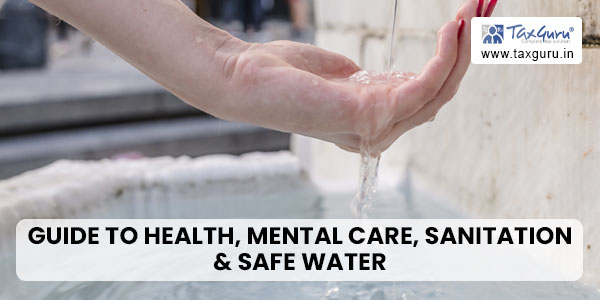SAS 200 Promoting health care including mental healthcare, sanitation and making available safe drinking water
Article Explore SAS 200, which focuses on impact assessment engagements in promoting healthcare, mental healthcare, sanitation, and safe drinking water. Article explains process of social audit, key metrics for evaluation, qualitative and quantitative criteria, limitations, and challenges. Article further explains significance of this audit in addressing fundamental societal requirements. Gain insights into the importance of healthcare and safe drinking water, and the role of social auditors in ensuring accountability and impact.
Introduction
It’s the second of the 16 SAS which will become effective once posted by ICAI. As the name suggests the SAS focusses on providing the Social Auditor (SA) guidance and knowledge on impact assessment engagements in the area “Promoting health care including mental healthcare, sanitation and making available safe drinking water”. The SAS provides glimpse of process and evaluation methodologies which the SA can partake in.
Process of Social Audit
The Process of Social Audit for SAS 200 is not much different from that defined in SAS 100 if you look at the broad picture. SAS provides perspicuous insight on whom the SA should approach in the process of data collection for its impact assessment assignment which shall include but not limited to:
- Direct beneficiaries
- Immediate family members of the direct beneficiaries
- Contractors/Suppliers
- Funding entities, Government (at block, district, state and national levels, as relevant) and related institutions
- Monitoring Agency
- Key program officials of the entity etc.
Data collected should be filtered and reviewed by the SA to gain a deep knowledge of the engagement. Data check examples may include:
- Cash subsidy/assistance provided
- Establishing healthcare institutions
- Conducting health camps along with pre and post health check-ups being conducted
- Subsidised health treatments provided e.g., Ayushman Bharat Yojana, Mahatma Jyotiba Phule Jan Arogya Yojana (in the state of Maharashtra) etc.
- Vaccination and immunization drives conducted Reduction of hardships of patients with special needs and patients with chronic needs.
- Accessibility for differently abled people
- Mortality rate inclusive of maternal mortality rate
- Intensive education and awareness campaigns conducted
Post data review SA should conduct physical inspection and have one on one interviews to get a first-hand grip of the assignment.

The process of social audit under this SAS will involve the SA asking himself and the people involved some questions which will form the bedrock of the entire Social Impact Assessment Report. Some of these questions are given below:
Did the target people receive the benefit?
- Did the standard of living improve?
- Did the life expectancy increase?
- Was there a reduction in number of patients?
- Was there any improvement in infrastructure facilities provided?
- Was there was any reduction in substance abuse?
- Was the health-care provided efficient?
- Were sufficient clean water and sanitation facilities provided?
- Were the facilities accessible to all irrespective of their socio or economic status or religion and to what extent are they being used.
Key Metrics: Framing and then assessment
Key areas of the project should be unerringly prepared by the SA and there should be a focussed review of project documents to derive these key impact areas. The SA should proceed in this manner:
- The baseline measurement is done to establish the starting point in any project/program, which is then used to measure what actually changed due to the intervention of the entity.
- Assess the past performance trend of the entity: This will enable to get a glimpse of what were the previous key metrics.
- Assess the highlights and key achievements during the reporting period: Whether these achievements and highlights are being met this time or not?
The evaluation of these questions and deriving of key metrics will help the SA to determine:
What would happen if these interventions are not there?
Negative impact of the project?
Evaluation Criteria
This can be broadly divided into Qualitative and Quantitively Criteria’s which remains same as other SAS and hence not being separately discussed in this article.
Some examples of both are:
(A) Quantitative Criteria
Promoting health care including mental health care and sanitation
1 Number and amount spent on medical institutions created
2 Number and amount spent on key equipment’s
3 Number of people vaccinated/ immunized through vaccination/ immunization drives along with categorisation of type of vaccine e.g., Polio, Tuberculosis, Hepatitis B, any other pandemic, etc. and with bifurcation of age groups
4 Details of reduced illness/ patients admitted
Making available safe drinking water
1 Number and amount spent on construction and maintenance of water purification plants and RO plants
2 Number and amount spent on borewells dug, underground water pipelines laid, drinking water supplied through water tankers.
3 Number of beneficiaries getting safe and adequate drinking water Piped Water Supply (PWS)
4 Generation and consumption of safe drinking water (in litres)
(B) Qualitative Criteria
1 Improvement in Economic conditions
Increased standard of living may be used to assess the improvement in economic conditions
2 Improvement in Health conditions
The following indicators may be used to assess the same:
- Better access to medical facilities
- Early detection of medical condition
- Overall reduced illness
Limitations and Challenges related to the audit under this SAS
In the implementation of any good obstacles are bound to come. It is up to the SA to recognise these challenges in advance and make adjustments for the same. Some of the examples of commonly faced issues in relation to promoting health care including mental healthcare, sanitation and making available safe drinking water may include the following:
- Social discrimination and exclusion: In a country like ours there still exists several discriminations in the name of caste, creed, sex and religion which results in a section of population being excluded from social programmes covered under this SAS.
- Insufficient number of medical institutions, medical equipment’s and medical professionals: There has been a dearth of good medical institutions and professionals especially in the rural areas.
- Resistance to change: They say change is inevitable but resistance to change continues in all aspects of life
- Lack of awareness of ri ghts, entitlements, schemes and entities working to provide this access: If you don’t know about your right then you can’t fight for it and neither you can access the benefits attached to it.
Limitations of the assessment
The Social Auditor should identify the inherent limitations of the evaluation process which might have an influence on the impact assessment. Some of the examples are:
- Cases of no-response in case the questionnaire is not administered in person
- Some of the questions being skipped by the respondents and remaining unanswered
- Non-availability of respondents after completion of the services provided
- Change in contact details of respondents due to which they could not be contacted
Any significant issues observed during the assessment, that may influence the user of the impact assessment in decision making, should be highlighted by the social Auditor in the social audit report
My Remarks/Conclusion
The above-mentioned SAS deals with one of the most fundamentals requirements of human society as a whole.
The SAS provides a brief glance of the process and challenges in such engagements. The SA will also have to depend upon his own judgement calls as no two engagements are the same. The SAS is covering an area which is also one of the priority segments of the government and as such room for error is limited in this audit.
Quote
“Water is life’s matter and matrix, mother and medium. There is no life without water.” ~ Albert Szent-Gyorgyi





